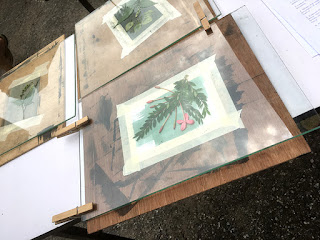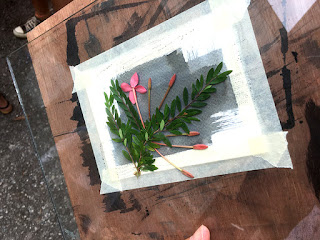I started drawing again because of an animation programme I took in 2009. Many might find that peculiar because 3D softwares like Maya was the main staple. During the first semester, drawing (with pencils) took up most of the day’s schedule - from short gestural poses to sketching simple still life set ups. The classically trained animation-based instructor, Philip Garcia, took us outside the classroom to draw too, like the zoo, botanic gardens, bird park and Gunther von Hagens' BODY WORLDS exhibition. That eye-opening semester began to change the way I thought about art.

The last time I picked up a pencil before the animation programme was probably during the first year of design college. After which, I used the mouse to draw logos, design advertising campaigns and churn out illustrative graphics. Fast forward to 2011 – the time after the animation programme. I headed to the city of Los Angeles for a short 3-month stint in concept design with some of my animation classmates. Most of the classes I signed up for were drawing classes at the Animation Guild in Burbank. It was there that I was able to study under two great living instructors of the human figure - Glenn Vilppu (bottom left) and Karl Gnass. Although I didn’t pursue the field of animation after the three months in LA, my appreciation for traditional arts deepened.
2012 was the year I decided to move away from a digital artist to become a traditional one. Some of the things I did to achieve this goal were to 1) request for more illustrative works, 2) buy an annual zoo pass and faithfully headed there once a week and 3) sign up for portrait studies and figure drawing at the local community clubs. I heard about Urban Sketchers Singapore (USKSG) who meet to sketch every month end and decided to join them. Finally, I was able to connect with like-minded people with a passion for drawing. I learned heaps about inks, watercolours and sketchbooks from the various art groups that I joined. The more I sketched, the more I craved for it. By the summer of 2012, I decided it was time to attempt a sketching journey on the Camino de Santiago and make a
book out of it.
 Sketching in the Pyrenees
Sketching in the Pyrenees
After completing 800km and using up four sketchbooks, a revelation hit me - life is too short to be doing something else. After publishing my first sketchbook in Dec 2012, I made plans to study art… from scratch. And by April 2013, I began my basic training at the Angel Academy in Florence under Maestro John Michael Angel. It was only a year after (spring of 2014), did I begin to learn the methods of oil painting like the traditional old masters.
The difference between ink sketching and oil painting
Initially I thought that I would be weaning off my ink and watercolour sketching at some point in order to focus on oil painting. But over time, I realized how the doodles that I do on the streets complemented my oil painting, and vice-versa. For example, the amount of ink sketching I do would directly translate to quicker and more accurate drawings in the painting stage. Likewise, the oil paintings I make sharpen the way I see values and depth, and that would allow me to easily apply those concepts while I’m sketching or watercolouring.
Using inks give me the needed breathing space away from oil paints. This time allows me to absorb and process what I just did, instead of moving immediately into the next project. It’s almost like giving the food I eat some time to be digested before rushing to my next meal.
I let myself stay loose when doodling in my sketchbook. When I do my oil paintings, I tend to be a little more precise and meticulous. This sketchbook play time helps me stay creative (without any boundaries) and maintains that balance I need as an artist.
The tools used for sketching takes up very little space, all I need is a pen and a piece of paper. This is crucial when I want to create art in tight spaces like cafes where an easel or the smell of turpentine is not too pleasing to customers. One of my favourite spaces to sketch would be onboard a plane. Imagine all that flying time to draw! 1
My oil paintings are usually kept for a specific group of art collectors. Sketching allows me to turn my art into products for the masses. I turn my sketches into books, posters, postcards, collar pins, mugs, etc... you name it. And I would put myself in art fairs to sell them and also use the opportunity to sell myself as an oil painter.
What inspires me to draw?
I get inspiration from everywhere. It could be a new cafe that just opened in the neighbourhood. Or an old coffeeshop that might be closing down permanently. It might be a book that I am working on that gets me sketching a certain theme like my recent book about the coffee scene in Singapore called
La Kopi.
Seeing beautiful work by other artists who share them on social media also encourages me to post mine online. It’s always a joy to be able to connect with another artist via social media.
I travel fairly often. For every trip that I make, I will sketch. Just being in a new environment and checking out the local sights and smell, it’s all eye candy for my sketchbook. I used to take home thousands of photographs when I travel. But ever since I got into the habit of sketching, I find more joy in being at a location where I can carefully observe (and sketch) the place or structure. It also opens up the possibility for communication between the locals. Sketching creates memories that are etched more deeply than what a photo can do. 2
I know a lot of urban sketchers around the world. When I travel, I make it a point to meet up and sketch with them. Not only are they a better guide of the city or town, it is always good to see how others approach the art of sketching within a certain region. 3
Commute Sketching is also a good way to practice figure drawing outside the studio environment. When I commute on a train or bus, I get models of different height, shapes and colour. And the best thing is that I don’t have to pay model fees. 4
Not a day goes by without me not sketching. If I take a 3-day break from drawing, I do see a difference when I get back to it – a drop in quality. It's subtle, but this reminds me how pen mileage makes the difference.
Besides the drawing and painting commissions I get, my next sketching journey takes me to Art in the Open in Wexford, Ireland where I will run a sketching workshop on July 30, following by a series of sketching trips to Bhutan. I am blessed to have all these opportunities as an artist. Looking back, I am ever so grateful to have taken that leap of faith during that Fall of 2011.
Video and blog links from the article above:
More on Commute Sketching:
More on The Short Pose:
- - - - - - - - - - - - - - - - - - - - - - - - - - - - - - - - - - - - - - - - - - - - - - - - - - - - - - - -
- - - - - - - - - - - - - - - - - - - - - - - - - - - - - - - - - - - - - - - - - - - - - - - - - - - - - - - -
Alvin Mark Tan is a traditional oil painter residing in Singapore. He also illustrates in ink and watercolour.
A graphic design graduate from Woodbury University in Burbank, California, Alvin began his graphic design career with the Ministry of Defence in Singapore. Later, at the Singapore Press Holdings, he branched out into advertising, environmental design and documentary-making. He also has an Animation diploma, with a focus in concept art.
After walking the Camino de Santiago in 2012, Alvin made a bold decision to sell and leave everything to study what he was always called to do - traditional oil painting. He graduated from Angel Academy of Art in Florence, Italy, where he studied Natural Realism under Maestro Michael John Angel for three years.
Apart from doing commissioned art works ranging from still lifes to portraits to ink sketches to wall murals, Alvin loves drawing directly from nature. So he is often outdoors doing plein air paintings, on the streets urban-sketching, or commute sketching in his travels. His goal by being a full-time artist, is to encourage people to live out their vocations in life.













































